- Books Name
- Physics by Anshu Physics Book
- Publication
- Madhava Publications
- Course
- CBSE Class 12
- Subject
- Physics
Electric Charges
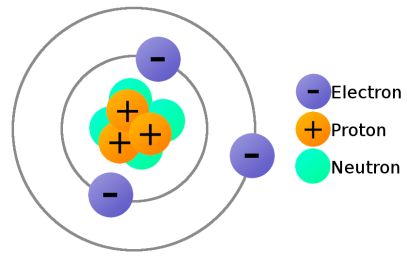
Take away from previous Knowledge:
You must have read about the Four Fundamental forces in the Universe - Strong force, Weak force, Gravitation force and Electromagnetic force. Out of these four, like Gravitation force arises due to the mass of the particles, Electromagnetic force is actually due to another intrinsic property of matter that is “ELECTRIC CHARGE”
Some matters have an intrinsic property other than mass which is “Electric charge”. For example electrons, and protons.
INTRODUCTION TO ELECTRIC CHARGES
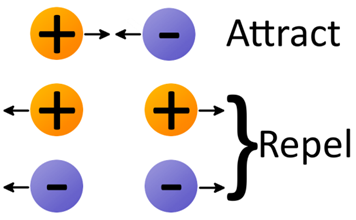
An electric charge is an intrinsic property of matter which is caused by electromagnetic interaction. Many physical phenomena like lightning, all phenomena related to charges and magnets can be explained by electromagnetic interactions.
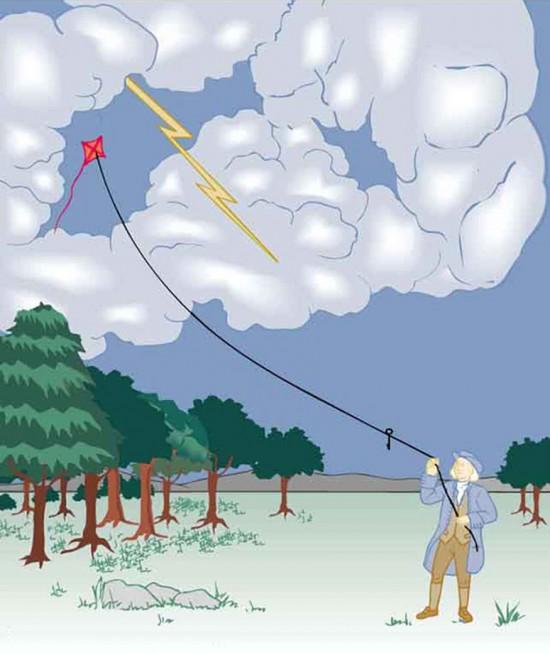
Types of charges: There are two kinds of charges in the universe. Electric charges can either be positive or negative. Like charges (same charges either both positive or both negative) repel each other and unlike charges (one positive and one negative) attract each other.
S.I units and Dimension of Electric Charges
S.I units of charge is Coulomb and Dimension is [ M0 L 0 T 1 A 1]
“Electron has the fundamental charge of - 1.6 *
Conductors and Insulators:
Free charges are responsible for the electric and thermal conductivity of the materials.
Materials with free charges can conduct electricity and hence are called conductors like metals. Example - Copper, silver etc. Materials that don’t have free charges cannot conduct electricity and hence are insulators. For example glass, Plastic.
Electrostatic Induction:
Electrostatic Induction is the phenomenon of temporary electrification of a conductor in which opposite charges appear at these closer ends and similar charges appear at its farthest end in the presence of a nearby charged body.
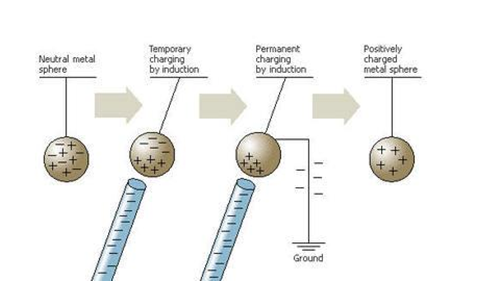
In the above situation, we initially have a neutral metal sphere. When we place a negatively charged rod near it, electrons surface near the rod will get repelled from the negative charge from the rod and move to another side of the sphere this the surface near the rod will become positive ( due to deficiency of electron ) and farther part becomes negative( due to excess of electrons). So that metal ball is temporarily charged by induction.
If we ground the sphere such that the excess electrons will move to the earth and thus leaving the metal as a positively charged metal sphere. This is called electrostatic induction.
Basic Properties of electric charges
Additive property of electric charges:
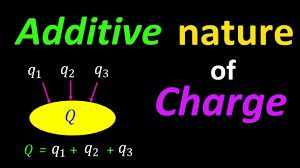
Electric charges can be added with their signs just like we add numbers.
The additive nature of electric charges means that the total charge of a system is the algebraic sum of all the individual charges located at different points inside the system.
Example: If inside a cavity we have some positive charges of 2 coulombs and negative charges of 4 coulombs then we can say that total charge in the cavity is “-2 C”.
Qtotal = Q1 + Q2 = +2 C + (-4 C) = -2 C.
In the same way, we can add many charges together along with their signs to get the total charge.
Let’s try to understand more about it.
Some Important facts: Conceptual questions
A body can be made negatively charged by giving some electrons to it. It can be made positively charged by removing some electrons from it.
Explanation: Since in an atom we have electrons and protons, electrons are comparatively free than the protons which are strongly bounded inside the nucleus. So to make a body negatively charged we cannot extract positive charge from it. But it can be done by giving excess electrons to it.
And similarly, when we wish to make a body positively charged we cannot give excess protons to it but we can remove some electrons from it so there would be net positive charge.
Remember Atom as a whole is always neutral as it contains an equal number of electrons and protons.
Can charge exist without mass?
One of the basic properties of Electric charge is that a charge is always associated with mass. A charge doesn’t exist without mass.
Earth is a source of an infinite positive and negative charge.
Earth can be considered an infinite source of positive and negative charges. This can be justified by the fact that if we connect any positive or negatively charged body to the ground, all of its charges will go to earth.
If a system has zero overall charge. Is it true there are no charges present in the system?
No. This is not true. There is a possibility that all positive charges cancel out all negative charges and the overall system has zero charges. For example, in any atom, we have an equal number of positive and negative charges so the net charges become zero, but there are still charges inside the atoms.
Conservation of Charge
In physics, charge is a conserved quantity and it cannot be destroyed or produced. Total charge in an isolated system remains conserved and can never change.
In other words, the net quantity of all the charges in the universe (positive-negative) is always conserved.
Quantisation of charge
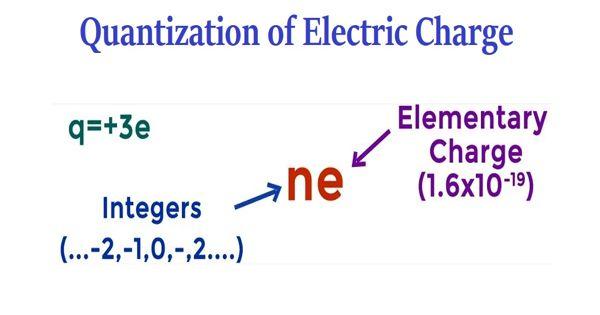
In the Universe, we have some fundamental particles like electrons. Fundamental particle means we cannot divide that particle. Like we can have either one electron, 2 electrons or so on. We cannot have anything like 2.5 electrons (any fraction) as we cannot have a fraction of an electron. So we can have only an integer number of electrons.
Now we know that charge is an intrinsic property of the particle along with its mass. An electron has an elemental charge which is 1.6* ![]() . So we can have only charge in the integer number of charges of electrons.
. So we can have only charge in the integer number of charges of electrons.
Q = n e
Where Q is charge; n is any integer
The quantization of any physical quantity means that it cannot vary continuously to have any arbitrary value but it can change discontinuously to take any one of only a discrete set of values.
The energy of the electron in an atom or the electric charge of a system is quantized.

 Grow Career Publication
Grow Career Publication
 Madhava Publications
Madhava Publications
